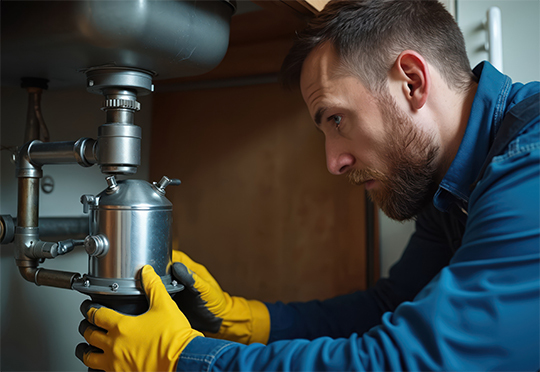
4 Keys to a Successful Safety Program, with Sam Watts
Building a safety program that “sticks” requires more than adding the latest tools and software to your repertoire. It takes the right conversations with the right people, clear plans to implement these tools into your current processes and a fair amount of planning — components that are something of a specialty for our friend and resident fleet safety expert, Sam Watts.
We caught up with Watts for his take on how best to build and implement a successful vehicle safety program, including four essential guidelines every business should follow when augmenting their safety processes.
1. Success starts at the top
Without a plan beyond “Well the powers that be thought it’d be a good idea,” businesses are likely to find themselves investing in tools that ultimately fail to change anything for the better. According to Watts, successful adoption hinges on leaders leading by example:
“If the owner's involved, the rest of the company will be. If they're not involved or they're not interested, nobody else is going to be — no matter how hard you try.”
Any attempt to shift a business’ status quo requires a fair amount of buy-in from everyone involved. Watts stresses the need for operations directors and dispatch managers to provide honest feedback, as well as anyone involved in day-to-day safety decisions and procedures. If company leaders aren’t aligned on what to expect from a new tool or procedure, the odds of it taking effect when it’s presented to drivers remain slim.
“You can't just be this authoritarian figure,” Watts says. “They're not going to listen to you, they're going to tune you out. I always like to get a little pocket of drivers and say, "Hey, this is what we're thinking. What are your thoughts?"”
2. Training takes priority
Speaking of safety tools’ desired effects, it’s pretty important everyone understands — in clear terms — what your company hopes to gain from all this. Evaluate your most obvious safety needs (e.g. speeding, seatbelt use, distracted driving; the ones that, when fixed, will noticeably move the needle) and determine which tools are available that can address these issues. Concrete priorities will help drivers get behind the whys and hows of any changes to the established program.
Oh, and no matter your selected area of emphasis where safety is concerned, make sure training stays firmly atop your task list.
“Policies are going to shift once you understand what the new software can do,” Watts says. “But I would hammer home the training right away. Train the drivers. Train the dispatchers, because there's going to be hiccups at the beginning, and the more that your dispatch team knows how to fix, the more they can help the drivers out. Training is going to be the most important part.”
3. Invest in the right tech (and then use it correctly)
The menu of available driver safety technologies is a lengthy one. Dash cams are must-haves (“your first little fender bender will pay for every dash cam in your fleet,” per Watts), but there are also fuel reports, DVIRs, CSA score, and vehicle maintenance trackers — the list goes on. Watts’ advice? Consolidate tech when you can; too many tools tend to foster confusion.
“It all comes down to what you’re looking for,” Watts says. “Do you have a shop that's doing everything? Maybe you don't need software tracking your maintenance stuff. Are you great at looking at the portal? Maybe you don't need the CSA. What else do you need? It's out there; just go find it.”
Fortunately, with a clear ranking of safety priorities in-hand you’ll be equipped to sidestep a pair of major safety program pitfalls: investing in tools you don’t need and gathering data you won’t use.
The first issue can be easily skirted by doing your homework (see above) before splurging on new software. Test different providers, take advantage of demos, and find the simplest solution possible for your business.
“Do you have a problem with driver speeding? The software isn’t going to slow them down, per se,” Watts says. “But it'll at least tell you who's doing it, where they're doing it and how much they're exceeding the speed limit so you can more effectively coach them on safer driving.”
The second issue — amassing more driver data than you plan to utilize — is a little more complex, and poses some sneakily severe risks to your company.
“If you're collecting all this data but you're not doing anything with it, and something were to happen, lawyers are going to come to you and say "Why didn't you do anything with this? You saw that this guy was speeding or braking harshly X times per day, why didn't you do anything about it?"”
4. Consider ease-of-use, accessibility, and customer service
Here’s one final consideration for any safety program, and one that should probably stay top-of-mind throughout the entire development process: is it simple to use?
Software needs to be user-friendly for all (even and especially the technologically challenged). The best tech and training will still likely experience some early hiccups when software is first implemented (in fact, it’s a good idea to check out a provider’s track record of customer support while you’re shopping around).
Make sure your new system is both simple to adopt and easy to access. Even once everything is running smoothly, Watts stresses the ability to view and troubleshoot safety tools from anywhere.
“Just this week I had to look stuff up on my phone because I wasn't at my office,” Watts says. “I’ve got to be able to pull up truck locations, dash cams and hours of service with just my phone.”
Coaching for better driver safety
The “why” behind any new safety tool or policy is to ensure drivers are operating safely on the road — simply becoming aware of certain bad habits can help reduce the rate of preventable incidents in a matter of weeks. For more dramatic changes to take root, regular coaching and monitoring will help take stock of each individual driver’s safe driving habits — as well as their potential knowledge gaps or safety blind spots.
A driver coaching dashboard (like Linxup's Coaching Dashboard with Coaching Sessions) can be beneficial in highlighting and resolving these bad habits, granting visibility into things like daily driving history, segmented trip breakdowns, and at-risk drivers. The dashboard is a clear way to gauge the impact of your safety program changes; Linxup’s in particular is capable of both creating and tracking custom coaching sessions to fit drivers’ individual tendencies.
No matter your particular area of emphasis, the core of every successful safety program begins with these principles: Buy-in at every level, effective training, researching the correct tech for the job and only adding tech that can be accessed and used from anywhere.



